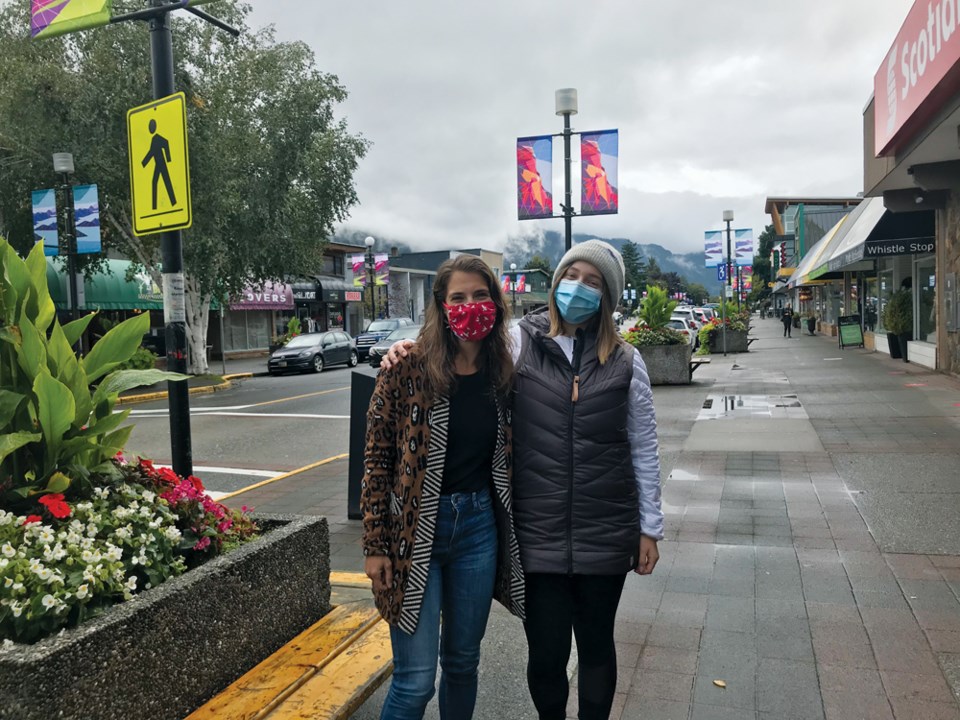Editor's update: Sarah Thompson died in November of 2020. She will be missed by many, including by us at the paper.
While the number of deaths in the opioid crisis scroll by on our newsfeeds like paper in a ticker-tape parade, the reality is that each death is a valuable and cherished loved one, say those who are closest to the crisis in Squamish.
“It is not happening somewhere else. It is happening here in our community and they are people who are loved and who are real people who are so important — and it could be anybody,” said Jenna Becker, project co-ordinator with the Sea to Sky Community Action Team. “It is really different, I think, than how people want to believe that is so far away.”
Sea to Sky CAT, led by Squamish Helping Hands and funded by the provincial government, is made up of representatives from various community organizations. The ensemble aims to tackle the overdose crisis in the Sea to Sky Corridor and come up with community lead solutions to save lives and reduce stigma.
Sarah Beech is involved with the community action team due to her lived experience.
She said she openly shares that she is in recovery because she wants to help reduce stigma in Squamish.
People who find out, can’t believe someone like her — an articulate, well dressed, healthy-looking young woman — has struggled with addiction.
“I am a recovering addict, and a recovering alcoholic,” she said, matter-of-factly. “An addict or an alcoholic can be anybody. It is your brother, your sister, your daughter, your mom.”
Stigma is harmful for those battling addiction and facing recovery, said Becker and Beech. People in these situations deserve to be treated with dignity just like everyone else, and there is hope for them.
“It is a painful thing to be in,” Beech said of addiction.
Her addiction started when she was very young, she said.
Being in recovery and slowly watching her friends die off due to the overdose crisis is also difficult, she said.
Her advice for those with friends and loved ones who are struggling is to be consistent.
“Letting them know that you are there for them once they are ready,” she said.
Becker noted that while there are many services in Squamish for those who use substances, it lacks a detox bed.
“Something I hear all the time is that when someone is ready to seek that help, if there isn’t something readily available, then you lose that person. To lose that person in that moment could mean that they are dying, because that is how crazy the drugs are now,” Becker said.
Residents currently have to leave Squamish for Vancouver in order to detox.
Most treatment centres require clients to have gone through detox before arriving.
Beech says when she was ready to detox, there wasn’t a bed.
She chose to detox at home, which was uncomfortable and didn’t feel safe, she said.
“It was very scary. Thankfully, I had the support of my friends and family members.”
She fears for the people who don’t have the support she has or who don’t have a stable roof over their heads.
By the numbers
There were 1,068 drug toxicity deaths in the province this year, as of Sept. 1.
So far in 2020, 84% of illicit drug toxicity deaths occurred inside, according to the BC Coroners Service.
Each month since the start of the pandemic has seen the number of deaths rise, to top 100 per month, stats from the service shows.
Post-mortem toxicology results suggest that there has been a greater number of cases with extreme fentanyl concentrations in April to August 2020 compared with previous months.
The doctor says
“I certainly would not contradict the voices you have heard in Squamish and probably other communities, that there are not the services required when people need them. That is an unfortunate reality,” said Dr. M-J Milloy, a research scientist at the British Columbia Centre on Substance Use (BCCSU).
The opioid crisis shows that there are too many gaps in care, he said.
“Even though they reach out their hand for help, unfortunately, that help doesn’t arrive on time from the medical system,” he said, adding that he was not criticizing those in critical medicine.
He said that trying to solve the opioid crisis as it and COVID rages is a bit like trying to build a plane and fly it at the same time.
“Many people are doing really heroic work on the front lines of harm reduction and critical medicine trying to save lives.”
Addressing the gaps in care should be a priority of whoever is elected in the next provincial election, he said.
“The BC Liberals, who were in power before Mr. Horgan took some important steps. Mr. Horgan’s government has taken some steps as well. But clearly, given the continuing toll of preventable death, more needs to be done to put in the clinical services and the harm reduction services to save people’s lives.”

Another Sarah’s story
Sarah Thompson’s life story sounds like the plot of a scary drama. She has survived much in her 26 years.
She has been revived from overdose twice; once when she was given cocaine that had been laced with fentanyl.
Thompson, who has been in recovery since January, said she works to be of service to others who are currently struggling.
There are so many factors that contribute to addiction, she noted.
“Whether that is a predisposition, being prescribed something for medical surgery and ending up addicted, or trauma,” she said. “Which leaves almost every single person at risk for addiction at some point in their life. It is hard to find people who have none of those factors.”
Those few people who have not faced any of the factors are usually the ones who believe addiction is a choice, Thompson said.
“The choice at the end of the day is up to us to stop that, but I think at this point with the crisis going on that it is important that we simply support and offer a safe supply of harm reduction supplies, and of drugs as well for people who are still using.”
In terms of her addiction, Thompson traces it, in part, to a family predisposition. She also had a serious back surgery when she was 16 for which she was prescribed opioids.
“I was 16 when I had my first drink of alcohol. I was 17 when I first smoked weed.”
She said she formerly suffered some mental health issues and was using as a coping mechanism for that.
“I started using cocaine when I was 19 and then MDMA on top of that.”
She used MDMA (Ecstasy or Molly) almost daily at one point after her best friend died.
“It was a downward spiral after that.”
Thompson has recently relocated from Squamish to Kelowna with her partner to be able to eventually afford a home. The couple will move into a carriage house on a hobby farm on Oct. 1. She can’t wait.
She said that Squamish is making great strides in addressing the crisis, especially compared with her new hometown.
“It is hard being away from the community in Squamish. There’s a lot more accessible support there for me and what I need. So, that has been a little hard.”
She said she will remain involved with Sea to Sky CAT.
Her advice for family and friends of people struggling with addiction is that you can’t force someone to get off drugs.
“You cannot keep someone sober if they don’t want to be sober,” she said.
“The only thing we can do is support people as families, as communities — however they need to be supported.”
She said the conversation that needs to be had with people in the throes of addiction is: “What do you need in terms of support?” and “How can we move you forward?”
As for her future, Thompson and her partner, who is also in recovery, are aiming for 1,000 days sober.
“Once we get to 1,000 days, we’ve got this,” she said.
“We’ve got this.”
What works
“In terms of people who are living with opioid use disorder, it is clear that engaging them on what we can — medicated assisted treatment — like methadone or methadone or buprenorphine helps them to reduce the likelihood that they would use drugs that are contaminated with fentanyl and reduces their risk of dying from an overdose or HIV. We know that this works,” said Milloy
No one wants to die of an accidental overdose, he said. Harm reduction also works.
“We can reduce the harms that people who are using drugs face. A good example is INSITE and other supervised injection site facilities where people who are using drugs can use them under medical supervision.”
No deaths have been reported at supervised consumption or drug overdose prevention sites, according to the BC Coroners Service.
Individuals who use and overdose around others who have a Narcan kit have been saved, Milloy said.
“These sorts of harm reduction interventions are important to save lives, and I would argue they are an important part of what we call the continuum of care.”
Very rarely is there one “silver bullet” for any given disease, he said. “The medical system works best when there are a variety of complementary treatments so that all the patients can be treated effectively. It is clear both harm reduction and other treatments that are geared more toward recovery — both are urgently needed to save lives during the current overdose crisis.”
It is important people know there is help and there is hope, though, he stressed.
“Overdose is something that can be prevented. People who are in overdose can be revived and more to the point, people who are living with substance use disorders have options.”
The role of trauma
“A lot of folks end up turning to substances as a coping mechanism to deal with a trauma,” said Becker, who has worked in the court system and with victim services.
“A lot of people who I have met along the way and who are in that world do have trauma as the sources of it.”
If someone is going to try to use less substances or quit altogether, then the trauma may rear its head and have to be addressed.
“It isn’t just isn’t about trying to get off the substances. It is about trying to deal with the reason you were using substances in the first place and making sure that there is counselling services available for folks and making sure there is CBT (Cognitive behavioral therapy), or trauma-informed practice or EMDR (Eye Movement Desensitization and Reprocessing.)”
She said that there are amazing services available in Squamish, but they could be better funded so more people could access them.
How to use Naloxone (Narcan) from Hello Cool World on Vimeo.
COVID-19
Beech said that seeing the overwhelming public and government response to COVID-19. has made her question why such a response was not possible for the overdose crisis, which has seen much higher numbers of people die in B.C.
“Part of me wonders, is that because these people... aren’t being valued and aren’t being seen?” she said.
“You just don’t have to be an addict or know an addict for this to really touch home. It should be a community response.”
At the same time, the pandemic and the response to it has made the overdose crisis worse.
“With COVID, I think everyone took to heart the danger of being with other people and being in proximity. So, folks started using alone more,” said Becker.
“People were really listening to what they were being told. And then there was reduced hours for services people were using, so people were using alone. That, on top of the fact that the border is closed — the supply is just really dirty. It is just really dangerous.”
For people who use substances, the risk of dying of overdose is way higher than it is of COVID, she stressed.
“That is something we are really trying to push now. Your risk of dying of overdose is much higher than of dying of COVID. Don’t use alone. If you are going to use alone, use the Lifeguard App.”

Decriminalization?
Recently, there has been a growing chorus of voices supporting decriminalization — removal of criminal penalties for drug law violations.
“The BCCSU has long advocated for removing criminal penalties for drug use,” Milloy said.
“Speaking plainly, putting people in cages because of their drug use does not work. The evidence shows it does not make people stop taking drugs, and, unfortunately, there are many serious unintended consequences.”
He said that evidence from Washington State showed people who are incarcerated and released have approximately 12 times the risk of dying from a fatal overdose.
“Folks who go to prison probably stop using drugs — their tolerance changes. When they come out, they use the same dose and that dose is now fatal because their tolerance has now changed,” he said. “That is one example of how the criminal justice-based approach to drugs has been counterproductive and, in my view — and [in] the view of the BCCSU and many researchers and people with lived experience across the world — ... that approach should be abandoned.”
Beech and Baker both support decriminalization as well.
“I am in support. Especially right now, we need a clean supply,” Beech said. “These people are just sick. Then, why are they not receiving the proper medical treatment? As a result of that not happening, it feeds into stigma huge.... We are just losing way too many people for it to go on with this current model. I am quite frankly sick and tired of burying loved ones.”
Milloy acknowledged that decriminalization isn’t a silver bullet. It won’t make the overdose crisis go away.
“But it will be a step in helping people get the help they need to go into recovery, to use harm reduction services and not be imprisoned because of it.”
“Many people have called on Mr. Horgan and Mr. Trudeau to do the right thing. To move toward decriminalization so that we can hopefully make better strides in results in the overdose crisis.”
As someone involved in cannabis research, he said, he has seen how cannabis legalization has been “remarkable.”
“Stigma is gone. People can self-identify as being cannabis users without that threat of the law, of incarceration and without the stigma that goes along with using a criminalized product.”

Resources in the Sea to Sky
Lifeguard App — can be downloaded at both the App Store and Google Play
Safer drug use support
Overdose outreach worker in Squamish:
Robert LeBlanc 604-848-8086
Harm reduction/needle exchange: Squamish Mental Health and Substance Use services:
8:30 a.m. to 4:30 p.m. 38075 2nd Avenue
Squamish Helping Hands Shelter
(24/7)7930 Third Avenue 604-815-4984
Opioid Agonist Therapy (OAT)
Mental Health and Substance Use services:
Drop-in clinics
38075 2nd. Avenue. 773-894-3200: Monday, 1 p.m. to 4 p.m.;
Wednesday 9 a.m. to 1 p.m. and
Thursday 10 a.m. to 2 p.m. ***
Medical
Suicide Crisis Line: 1-800-784-2433
Mental Health and Substance Use
Info Line: 811
Squamish Mental Health and Substance Use Services: 779-894-3200
Access Central (Detox Info and Booking): 866-658-1221
Squamish General Hospital: 604-892-5211
Food/Shelter/Recovery
Sea to Sky Community Services
8:30 a.m. to 4:30 p.m. 604-892-5796
Squamish Nation Totem Hall
Monday to Friday 8:30 a.m. to 10:30 p.m. 604-892-5166
Howe Sound Women’s Centre (10 a.m. to 4 p.m. Monday to Thursday) 604-892-5748
Squamish Food Bank 604-815-4054
Alcoholics Anonymous (AA) Meeting/Info line (24/7) 604-815-4089
SMART Meetings (Self-Management And Recovery Training) 778-894-3200.
***Please note, this story has been corrected to inlcude that the Opioid Agonist Therapy (OAT) drop-in days include Thursdays not Fridays. The Chief was given outdated information.



